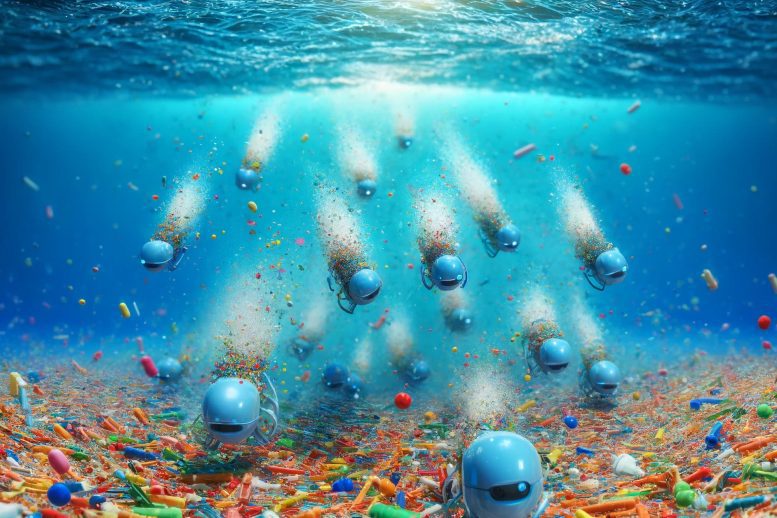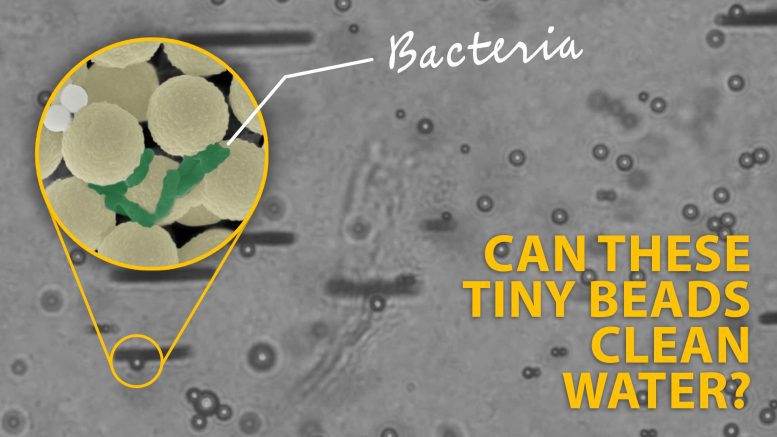
Innovative microrobots that imitate natural swarms can remove microplastics and bacteria from water, providing a reusable solution to water pollution. (Artist’s concept.) Credit: SciTechDaily.com
Scientists have created microrobots that can eliminate microplastics and bacteria from water, addressing the problem of pollution and disease spread in aquatic environments.
When old food packaging, discarded children’s toys, and other poorly managed plastic waste break down into microplastics, they are even more challenging to clean up from oceans and waterways. These small pieces of plastic also attract bacteria, including disease-causing ones. In a study, ACS Nano, researchers detail how swarms of tiny robots gathered plastic bits and bacteria from water. Afterwards, the robots were decontaminated and reused. Watch a video of the process:
In a report published in ACS Nano, researchers developed small magnetic beads that move through polluted water, collecting contaminants such as microplastics and bacteria.
The small size of microplastics, which are 5 millimeters or less in measurement, adds an additional layer to the plastic pollution issue because animals might ingest them, potentially harming themselves or passing the particles up the food chain to humans. The health effects for people are not entirely understood at this point.
However, the concern is not only about microplastics themselves. These fragments attract bacteria, including pathogens that can also be ingested. To simultaneously remove microbes and plastic from water, Martin Pumera and colleagues turned to microscale robotic systems, composed of numerous small parts that collaborate, mimicking natural swarms like schools of fish.

To purify water, researchers have designed swarms of small, round robots that gather bacteria and tiny plastic pieces. Credit: American Chemical Society
To create the robots, the team connected strands of a positively charged polymer to magnetic microparticles, which only move when subjected to a magnetic field. The polymer strands, extending from the bead's surface, attract both plastics and microbes. The final products, the individual robots, measured 2.8 micrometers in diameter.
When exposed to a rotating magnetic field, the robots grouped together. By adjusting the number of robots that organized into flat clusters, the researchers found they could change the swarm’s movement and speed.

To purify water, scientists have developed swarms of small, spherical robots (light yellow) that gather bacteria (green) and small pieces of plastic (gray). Credit: Adapted from ACS Nano 2024, DOI: 10.1021/acsnano.4c02115
In laboratory experiments, the team recreated microplastics and bacteria in the environment by introducing fluorescent polystyrene beads (1 micrometer-wide) and actively moving Pseudomonas aeruginosa bacteria, which can lead to pneumonia and other infections, to a water tank. Next, the researchers added microrobots to the tank and exposed them to a rotating magnetic field for 30 minutes, turning it on and off every 10 seconds. At a robot concentration of 7.5 milligrams per milliliter, the densest of the four concentrations tested, approximately 80% of the bacteria were captured. Meanwhile, at this same concentration, the number of free plastic beads also gradually decreased as they were attracted to the microrobots. Later, the scientists gathered the robots using a strong magnet and used sound waves to separate the bacteria attached to them. They then exposed the removed microbes to ultraviolet light, finishing the disinfection. When reused, the cleaned robots still collected plastic and microbes, although in smaller amounts. The researchers point out that this tiny robotic system offers a promising method for getting rid of plastic and bacteria in water.
Reference: “Magnetic Microrobot Swarms with Polymeric Hands Catching Bacteria and Microplastics in Water” 8 May 2024,
DOI: 10.1021/acsnano.4c02115
The authors acknowledge funding from the European Regional Development Fund/Europeal Social Fund project TECHSCALE, the REFRESH program of the European Union and CzechNanoLab. ACS Nano.
Researchers have developed microrobots capable of removing microplastics and bacteria from water, addressing the dual threat of pollution and disease spread in aquatic environments. When…
The authors acknowledge funding from the European Regional Development Fund/Europeal Social Fund project TECHSCALE, the REFRESH program of the European Union and CzechNanoLab.



